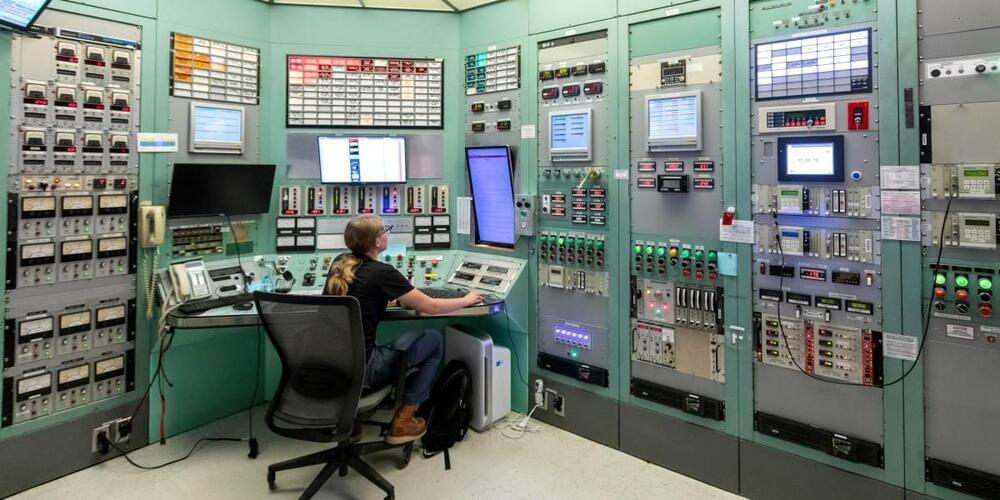How an old reactor could spark new technologies.
Category: nuclear energy – Page 41
DRACO is a demonstrate prototype of a nuclear-powered rocket that is scheduled for launch in 2027.
Deep space is a hostile environment for humans, which makes the long journey to Mars a serious stumbling block for manned missions. A nuclear-powered rocket could slash the journey time, and NASA has announced plans to test the technology by 2027 at the latest.
Most spacecraft to date have used chemical rockets packed with fuel and oxidizer, which rely on combustion to propel them through space. A nuclear-powered rocket would instead use a fission reactor to heat liquid hydrogen to very high temperatures and then blast it out the back of the spacecraft.
These kinds of engines could be up to three times more efficient than those in conventional rockets, and could cut the time to transit from Earth to Mars from roughly seven months to as little as six weeks. NASA has teamed up with DARPA to make the idea a reality, signing a deal with defense contractor Lockheed Martin to launch a working prototype into space as early as 2025.
US scientists have achieved net energy gain in a nuclear fusion reaction for the second time since a historic breakthrough in December last year in the quest to find a near-limitless, safe and clean source of energy.
Scientists at the California-based Lawrence Livermore National Laboratory repeated the breakthrough in an experiment in the National Ignition Facility (NIF) on 30 July that produced a higher energy yield than in December, a Lawrence Livermore spokesperson said.
Using a 192-beam laser at Lawrence Livermore National Laboratory’s National Ignition Facility, researchers heated and compressed hydrogen atoms, exceeding solar temperatures.
Researchers at the Lawrence Livermore National Laboratory (LLNL) in California have successfully repeated the breakthrough experiment in nuclear fusion performed in December last year, Reuters.
The experiment performed on July 30 had a higher yield than what was obtained in December, a spokesperson said.
😗😁 year 2022.
Nuclear startup Avalanche Energy has modest funding, a skeleton crew, a pocket-sized prototype — and grand ambitions.
Scientists have achieved a net energy gain in nuclear fusion for the second time, marking major progress towards realising the potential of the near-limitless energy source.
A team at the Lawrence Livermore National Laboratory in California, who first achieved the feat last December, claimed to have passed a new milestone with fusion ignition by producing even greater energy output than the original experiment.
The nuclear fusion process has been described as the “holy grail” of clean energy, as it requires no fossil fuels and leaves behind no hazardous waste. Instead it mimics the natural reactions that occur within the Sun, though harnessing its potential has puzzled scientists since the 1950s.
They finally reached ignition again last week, according to a statement Sunday from the lab. The news was first reported by the Financial Times.
“In an experiment conducted on July 30, we repeated ignition,” the statement read. “Analysis of those results is underway. As is our standard practice, we plan on reporting those results at upcoming scientific conferences and in peer-reviewed publications.”
Unlike fission, the process used in current nuclear power plants, fusion involves smashing atoms together instead of splitting them apart. It theoretically can supply carbon-free energy without long-lasting radioactive waste. But generations of scientists have struggled to master it in a controlled reaction, even though it has been the power source of nuclear weapons for decades.
A collaboration of nuclear theorists at the U.S. Department of Energy’s (DOE) Brookhaven National Laboratory, Argonne National Laboratory, Temple University, Adam Mickiewicz University of Poland, and the University of Bonn, Germany, has used supercomputers to predict the spatial distributions of charges, momentum, and other properties of “up” and “down” quarks within protons. The results, just published in Physical Review D, revealed key differences in the characteristics of the up and down quarks.
“This work is the first to leverage a new theoretical approach to obtain a high-resolution map of quarks within a proton,” said Swagato Mukherjee of Brookhaven Lab’s nuclear theory group and a co-author on the paper. “Our calculations show that the up quark is more symmetrically distributed and spread over a smaller distance than the down quark. These differences imply that up and down quarks may make different contributions to the fundamental properties and structure of the proton, including its internal energy and spin.”
Co-author Martha Constantinou of Temple University noted, “Our calculations provide input for interpreting data from nuclear physics experiments exploring how quarks and the gluons that hold them together are distributed within the proton, giving rise to the proton’s overall properties.”
SHINE Technologies.
With the world looking for cleaner ways to meet its energy demands, nuclear power is gaining favor once again as a low-carbon source of energy. Companies are also focused on harnessing energy from nuclear fusion instead, which does not raise concerns about nuclear waste.









